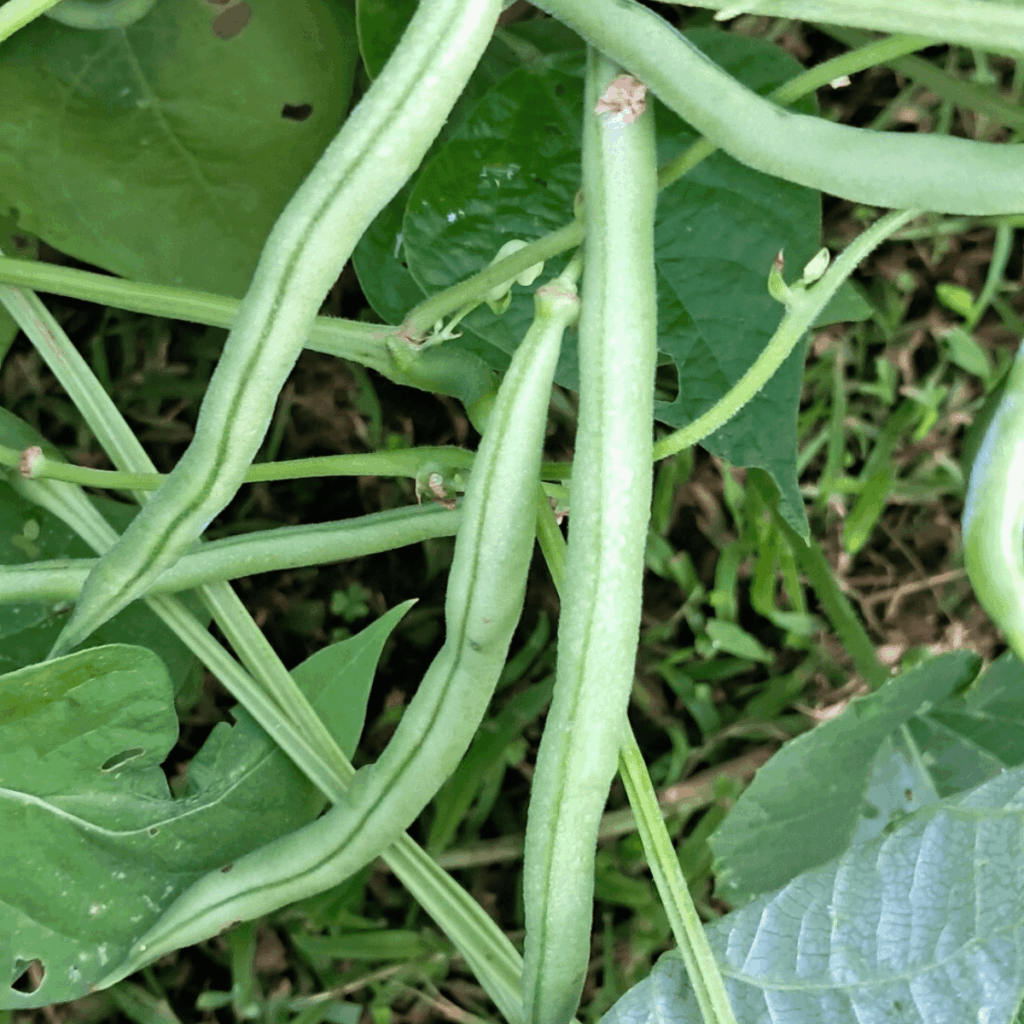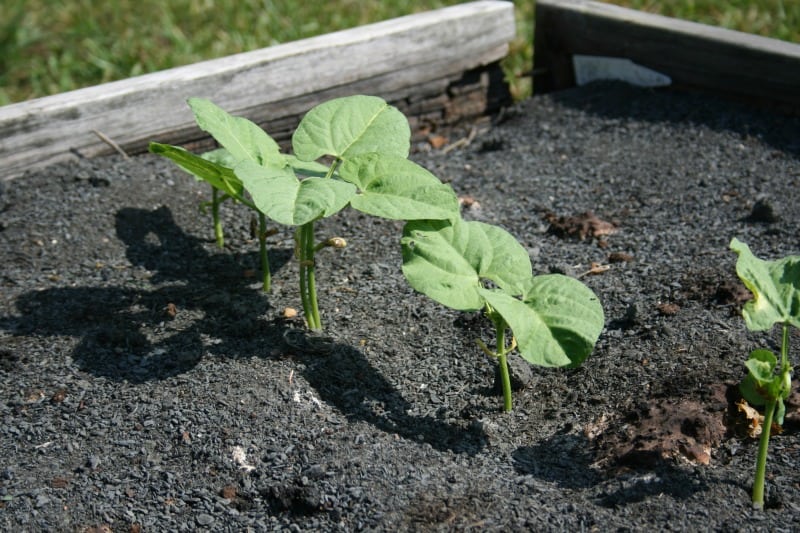Beans – whether green beans, snap beans, heirloom beans, or any other kind of beans – are easy to grow organically. They need warm temperatures, full sunshine, and fertile soil to grow at their best. While there are insect pests that will eat the leaves of bean plants, they generally don’t harm the beans themselves, and most organic gardeners simply skip the pesticides and add plenty of compost to the soil for fertilizer. The secret to learn how to grow green beans is to enrich the soil well before planting them, and to rotate your crops so that you don’t grow beans in the same location each year.
Please note that this post contains affiliate links. Home Garden Joy participates in the Amazon Affiliates program and makes a small commission when you purchase products using our links. This does not affect your price in any way. Thank you for supporting Home Garden Joy.
Plant Profile: Green Beans (Phaseolus vulgaris)
Botanical Name: Phaseolus vulgaris
Light Requirements: Green beans thrive in direct sunlight and require at least 6–8 hours of sun per day for optimal growth and pod production.
Soil Requirements: Well-draining, loamy soil with a pH that is slightly acidic to neutral (6.0–7.0). All bean plants like moderately rich soil but will grow in almost any soil, even poor soils.
Water Requirements: Water regularly, especially during flowering and pod development, about 1 inch per week, depending on rainfall.
Fertilizer: I don’t fertilize my green bean plants. Instead, I work in plenty of mushroom soil and compost in the spring before planting the seeds. Too much fertilizer results in lush plants with few flowers, which in turn results in low crop yield.
Planting Instructions
Direct sow outdoors after the last frost when soil temperature reaches at least 55°F (13°C). This is usually in the spring, after Mother’s Day in most gardening zones in the United States.
To plant bush beans, sow the seeds 1 inch deep, 2–4 inches apart in rows 18–24 inches apart. For pole beans, sow seeds 1 inch deep, 4–6 inches apart with trellis or support in place. You can use bamboo stakes, wire tomato cages
Succession Planting: For continuous harvest, sow new seeds every two weeks. Pole beans require vertical support such as stakes, cages, or teepees. Some inexpensive ones are available, including this spiral support (which looks neat in the garden, too), this pole bean teepee from Gardens Alive, and this larger trellis if you’re growing a big row of pole beans.
What Kind of Beans Should I Grow?
There are many different kinds of beans to choose from when you decide to grow beans organically.
Pole Beans
Many people grew up with these kinds of garden beans. They grow on a vine and need a pole to twine around, hence the name “pole bean.” A trellis or wire mesh fence can also be used to support these beans. They produce prolific amounts of bean pods, which are best when picked and eaten fresh or canned to enjoy later. You can find good pole bean seeds from Survival Seeds here.


Bush Beans
When space is at a premium, bush beans are the perfect choice. Instead of twining up a pole or another support, they grow in a bush-like shape and produce beans on the main plant. My favorite variety is the “Blue Lake Bush Green Bean” series. You can purchase these at your favorite garden center or home and garden store in the spring, or I prefer the Burpee Blue Lake seeds.
How to Grow Green Beans Using Organic Gardening Methods
Choose a spot in your garden for your organic green beans that receives six or more hours of sunlight per day. You can grow green beans in partial shade, but they are more prone to mildew diseases and may not yield as good a harvest as beans grown in full sun. Whenever possible, choose a spot that receives full sun.
Enriching the soil is very important for growing organic green beans. If you have a compost pile, dig up your best compost – the kind that looks like crumbled chocolate cake and is filled with fat, healthy, and happy worms. That sounds gross, but it’s the best compost there is. My dad used to call it “black gold” and he would say “It’s worth it’s weight in gold!” To your plants, it’s better than gold, because it is filled with beneficial macro and micro nutrients as well as microorganisms that enrich the soil.
Dig in as much compost as you can and loosen the soil to a depth of about six inches. Mix the compost in well. Plant after mixing in the compost.
Plant Beans from Seeds
Beans are very easy to start from seeds. You do not need to purchase plants at the garden center. One package of seeds should be sufficient for an entire summer’s worth of green beans.
Dig a trench and plant bean seeds directly into the garden soil after all danger of frost is past. The soil temperature should be in the 60s and 70s when you plant beans. They won’t germinate if it is too cold.
Plant the seeds about 1 inch deep and follow the spacing directions on the back of the bean package. Some varieties need more space than others. Cover the bean seeds with soil, pat the soil with your hand, and water well. Water the beans regularly to supplement rainwater.
Harvesting and Storing Beans
Pick bean pods when they are young and tender. Pick them frequently, as many bean plants will produce a second and even a third crop after you pick the first beans. Beans are excellent when canned and are great for quick salads or meals during the wintertime when you are craving fresh, organic produce. Canning your organic beans will also save you quite a bit of money during the winter months. Always use a pressure canner to can green beans and follow all directions precisely.
Learn how to can green beans safely here: Iowa State Extension – Safely Canning Green Beans
Organic Pest Control for Green Beans
There are several kinds of beetles that will go after bean plants. Most chew the leaves, and some suck the liquids from the leaves. Organic gardeners usually choose not to use conventional pesticides. As previously mentioned, floating row covers can discourage hungry pests, but there are other organic gardening practices you can use to prevent insect damage.
- Companion planting uses other plants to repel insects as well as enhance yield for certain plants. Marigolds, calendula and rosemary are good companion plants for beans. Calendula and marigold are said to repel many insects.
- Neem oil is an organic oil made from the neem tree of India that can be used on the leaves of bean plants. As with any organic oils or sprays, follow the directions on the bottle for use. Neem oil is also good for roses.
- Traps for beetles may be helpful to contain or control heavy infestations.
- Hand-pick beetles off the plants and dump them in a container of soapy water.
As an organic gardener, my choice is to leave my plants alone as much as possible. Sometimes the bean leaves look like lace, but they still produce plenty of edible green beans. My article on organic control methods for Japanese beetles will help you if you discover these pests dining on your plants.




